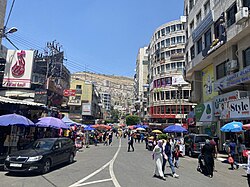
Back Nablus ALS Sihhem ANG نابلس Arabic نابلس (مدينه فى محافظه نابلس) ARZ Nablus AST Nablus (şəhər) Azerbaijani Наблус Byelorussian Наблус Bulgarian নাবুলুস Bengali/Bangla Nablus Catalan
Nablus | |
|---|---|
| Arabic transcription(s) | |
| • Arabic | نابلس |
| • Latin | Nābulus (official) |
Left-to-right from top: Nablus and Mount Gerizim skyline; Manara Clock Tower and An-Nasr Mosque; Joseph's Tomb chamber; Old City of Nablus; Tell Balata archaeological site; Eastern Orthodox Church of Bir Ya'qub, where Jacob's Well is located; Mount Ebal; and a Nablus shopping district. | |
Location within the State of Palestine | |
| Coordinates: 32°13′20″N 35°15′40″E / 32.22222°N 35.26111°E | |
| Palestine grid | 174/180 |
| Country | Palestine |
| Governorate | Nablus Governorate |
| Founded | 72 CE |
| Government | |
| • Type | Municipality Level A (from 1995) |
| • Head of Municipality | Adly Yaish |
| Area | |
• City | 28,564 dunams (28.6 km2 or 11.0 sq mi) |
| Population | |
• City | 174,387 |
| • Density | 6,100/km2 (16,000/sq mi) |
| • Metro | 431,584 |
| Website | www |
Nablus (/ˈnæbləs, ˈnɑːbləs/ NA(H)B-ləs; Arabic: نابلس, romanized: Nābulus, locally [ˈnæːblɪs] ⓘ)[a] is a city in the West Bank, Palestine, and the capital of the Nablus Governorate. It is located approximately 49 kilometres (30 mi) north of Jerusalem,[5] between Mount Ebal and Mount Gerizim with a population of 156,906.[1] The city is a commercial and cultural centre of Palestine, home to An-Najah National University, one of the largest institutions of higher learning in Palestine, and the Palestine Stock Exchange.[6] Nablus is under the administration of the Palestinian National Authority (PNA).
Nablus has been traditionally associated with the ancient city of Shechem.[7] However, Shechem is now identified with the nearby site of Tell Balata in the Balata al-Balad suburb of the West Bank. The modern name of the city can be traced back to the Roman period, when it was named Flavia Neapolis by Roman emperor Vespasian in 72 CE. During the Byzantine period, conflict between the city's Samaritan and newer Christian inhabitants peaked in the Samaritan revolts that were eventually suppressed by the Byzantines by 573, which greatly dwindled the Samaritan population of the city. Following the Muslim conquest of the Levant in the 7th century, the city was given its present-day Arabic name of Nablus. After the First Crusade, the Crusaders drafted the laws of the Kingdom of Jerusalem in the Council of Nablus, and its Christian, Samaritan, and Muslim inhabitants prospered. The city then came under the control of the Ayyubids and the Mamluk Sultanate. Under the Ottoman Turks, who conquered the city in 1517, Nablus served as the administrative and commercial centre for the surrounding area corresponding to the modern-day northern West Bank. Much of Nablus' history is preserved in its Old City, which contains more than 100 monumental buildings.
After the city was captured by British forces during World War I, Nablus was incorporated into Mandatory Palestine in 1922. The 1948 Arab–Israeli War saw the entire West Bank, including Nablus, occupied and annexed by Transjordan. Since the 1967 Arab–Israeli War, the West Bank has been occupied by Israel; since 1995, it has been governed by the Palestinian Authority as part of Area A of the West Bank. Today, the population is predominantly Muslim, with small Christian and Samaritan minorities.
- ^ a b Preliminary Results of the Population, Housing and Establishments Census, 2017 (PDF). Palestinian Central Bureau of Statistics (PCBS) (Report). State of Palestine. February 2018. pp. 64–82. Retrieved 24 October 2023.
- ^ "PCBS | Projected Mid -Year Population for Nablus Governorate by Locality 2017-2026".
- ^ "Palestinian Territories: Administrative Division (Territories and Governorates) - Population Statistics, Charts and Map".
- ^ "Nablus Urban Area: Joint Urban Planning and Development" (PDF). molg.pna.ps. Retrieved 8 September 2024.
- ^ "Distance Calculator". Stavanger, Norway: Time and Date AS. 2013. Retrieved 10 March 2013.
- ^ Amahl Bishara, ‘Weapons, Passports and News: Palestinian Perceptions of U.S. Power as a Mediator of War,’ in John D. Kelly, Beatrice Jauregui, Sean T. Mitchell, Jeremy Walton (eds.) Anthropology and Global Counterinsurgency, pp.125-136 p.126.
- ^ 'The present Nābulus is a corruption merely of Neapolis; and Neapolis succeeded the more ancient Shechem. All the early writers who touch on the topography of Palestine, testify to this identity of the two.' William Smith (ed.) Dictionary of the Bible,, rev. and edited by H.B.Hackett and Ezra Abbot, Hurd & Houghton New York 1870, vol.IV, "Shechem"' pp.2952–2958, p.2953.
Cite error: There are <ref group=lower-alpha> tags or {{efn}} templates on this page, but the references will not show without a {{reflist|group=lower-alpha}} template or {{notelist}} template (see the help page).










